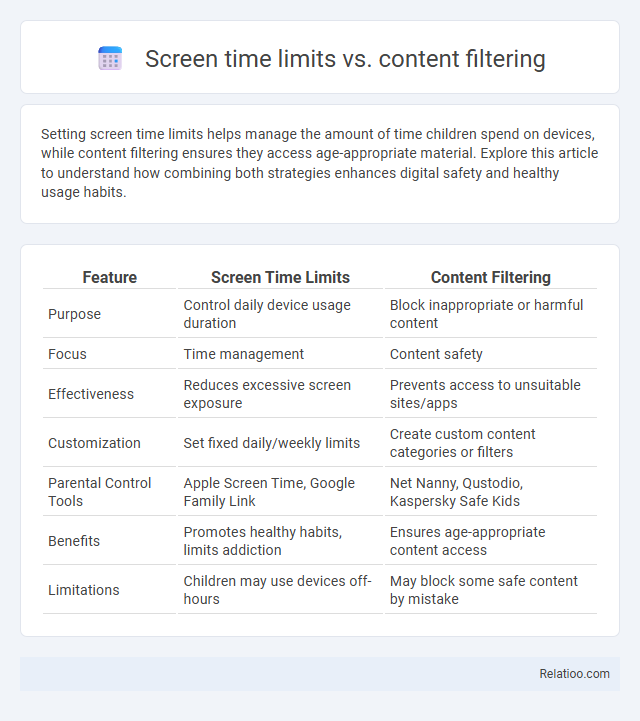Setting screen time limits helps manage the amount of time children spend on devices, while content filtering ensures they access age-appropriate material. Explore this article to understand how combining both strategies enhances digital safety and healthy usage habits.
Table of Comparison
| Feature | Screen Time Limits | Content Filtering |
|---|---|---|
| Purpose | Control daily device usage duration | Block inappropriate or harmful content |
| Focus | Time management | Content safety |
| Effectiveness | Reduces excessive screen exposure | Prevents access to unsuitable sites/apps |
| Customization | Set fixed daily/weekly limits | Create custom content categories or filters |
| Parental Control Tools | Apple Screen Time, Google Family Link | Net Nanny, Qustodio, Kaspersky Safe Kids |
| Benefits | Promotes healthy habits, limits addiction | Ensures age-appropriate content access |
| Limitations | Children may use devices off-hours | May block some safe content by mistake |
Introduction to Screen Time Limits vs Content Filtering
Screen time limits regulate the duration children spend on devices, promoting healthy usage patterns and reducing the risk of digital addiction. Content filtering restricts access to inappropriate websites, apps, and media by blocking harmful or age-inappropriate material. Both strategies form crucial components of parental control, supporting safer and balanced digital experiences for children.
Understanding Screen Time Limits
Screen time limits manage the duration your child spends on devices, promoting healthy usage habits and reducing digital fatigue, while content filtering blocks inappropriate or harmful websites and apps based on specific criteria. Parental control combines both by giving you comprehensive tools to regulate time, monitor content, and set restrictions tailored to your child's age and needs. Understanding screen time limits helps you balance device use effectively, ensuring your child's digital engagement supports their overall well-being and development.
Overview of Content Filtering
Content filtering technology restricts access to inappropriate or harmful websites, applications, and online media by analyzing and blocking specific content categories based on predefined criteria. Unlike screen time limits that control the duration of device usage and parental controls that combine multiple protective features, content filtering specifically targets the quality and safety of the material accessible to children. This approach enhances online safety by preventing exposure to explicit, violent, or otherwise unsuitable digital content across devices and platforms.
Key Differences Between Screen Time Limits and Content Filtering
Screen time limits regulate the amount of time a child spends on devices, ensuring balanced usage and preventing overexposure, while content filtering specifically blocks or restricts access to inappropriate websites, apps, or media based on age-appropriate criteria. Parental control encompasses both screen time limits and content filtering, combining timing restrictions with content monitoring for comprehensive digital safety. Screen time limits focus on duration management whereas content filtering targets content suitability, addressing distinct aspects of child online protection.
Benefits of Implementing Screen Time Limits
Implementing screen time limits helps prevent excessive device usage, promoting healthier sleep patterns and reducing eye strain in children. Setting clear boundaries encourages balanced daily routines and supports improved focus on homework or physical activities. Screen time limits also foster better family interaction by ensuring technology doesn't interfere with quality time.
Advantages of Content Filtering for Families
Content filtering offers families a tailored approach to internet safety by blocking harmful or inappropriate websites and applications while allowing access to educational and age-appropriate content. It enhances children's online experience by automatically restricting explicit material without constant parental supervision, reducing the risk of exposure to cyberbullying, pornography, and malware. Unlike screen time limits, content filtering maintains children's digital engagement within safe boundaries, promoting healthier online habits and peace of mind for parents.
Potential Drawbacks and Limitations
Screen time limits may restrict total device usage but often fail to address the quality of content consumed, potentially leaving children exposed to inappropriate material. Content filtering systems sometimes produce false positives or negatives, blocking educational resources while allowing harmful content to slip through, thereby reducing their reliability. Parental control tools can be circumvented by tech-savvy children and may infringe on privacy, leading to trust issues and less effective supervision.
Combining Screen Time Limits with Content Filtering
Combining screen time limits with content filtering enhances parental control by regulating both the duration and the quality of digital usage, ensuring children engage with age-appropriate content while preventing excessive device use. Screen time limits restrict daily usage hours, reducing risks of digital addiction and promoting a balanced lifestyle, while content filtering blocks harmful websites and inappropriate media, safeguarding mental and emotional health. Integrating these features within parental control apps delivers a comprehensive digital safety net, optimizing kid-friendly online experiences and supporting effective family technology management.
Factors to Consider When Choosing Parental Controls
When choosing parental controls, consider the balance between screen time limits, content filtering, and overall control features to address Your child's specific needs and behaviors. Screen time limits help regulate device usage duration, while content filtering blocks harmful or inappropriate material, and comprehensive parental controls combine both with monitoring capabilities. Evaluating device compatibility, ease of use, customization options, and reporting functions ensures the selected parental control solution effectively supports Your family's digital safety goals.
Best Practices for Balancing Digital Safety and Independence
Screen time limits help regulate device usage by setting specific durations, promoting healthy digital habits while preventing overexposure. Content filtering restricts access to inappropriate websites and apps through customizable categories, ensuring children encounter age-appropriate material. Parental control combines these strategies with monitoring tools and permission settings, enabling guardians to balance digital safety with fostering autonomy and responsible online behavior.

Infographic: Screen time limits vs Content filtering
 relatioo.com
relatioo.com